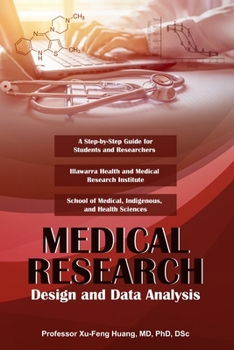Medical Research Design and Data Analysis
Who is this book for? Today, clinicians, health workers, and medical researchers require comprehensive knowledge to read literature, design research projects, and analyze data. This textbook provides the theoretical background and practical skills needed to read, interpret, appraise, and write research papers. Information is presented straightforwardly and placed into the context of actual research studies, helping the reader make real-life connections. The aim of this book is to: (1) develop the ability to read, understand, and evaluate current professional literature, (2) learn research methods and data analysis, (3) gain the skills and knowledge required to undertake and interpret research, and (4) have the skills to critically appraise a research paper in the medical, biomedical and health science fields. Research design. A strategy addresses the research question by using appropriate methods and techniques. The research question will determine the research design and measurements. Here, we introduce the nature of research; evidence-based medicine; research design basics; descriptive, observational, and correlation studies; randomized controlled trials; sample size determination; and research validity, bias, and con-founders. Data analysis. A process of data generates meaningful insight and supports decision-making. Starting with the basics, we describe the data type and distribution, introduce how to measure the data and variables, construct valid hypotheses, and then depict statistical methods, including parametric and non-parametric analysis. These skills will help you collect, sort, condense, model, and evaluate the research data, which are the foundations for outcome presentation, discussion, and conclusion. Project appraisal. A project requires a compelling story in a defined structure, communicating the science to the reader. Correct research design and analysis lead to high-quality outcomes and avoid misinterpretations. Key features of the book:
Research design introduces (1) the nature of research, evidence-based medicine, research design basics, and specific questions; (2) the descriptive, observational, and correlation studies and randomized controlled trials; and (3) the sample size determination and research validity, bias, and con-founders. Data analysis includes (1) medical data type, distribution, and measurements; (2) research hypothesis, significance, and error types; and (3) parametric and non-parametric analyses. Studying the content will lead you to (1) develop the ability to read, understand, and evaluate current medical literature; (2) learn research methods and data analysis; (3) have the skills to critically appraise a research paper in the medical, biomedical, and health science fields. About the Author: Professor Xu-Feng Huang, MD, PhD, DSc is a Medical Research Leadership Fellow of the National Health and Medical Research Council of Australia. He has taught courses including Human Anatomy, Motor Control and Dysfunction, Pathophysiology, Neuroanatomy, and Research Method and Analysis in Australia over the last twenty-five years. He published 316 full research papers, three coauthored books, and nine book chapters. His work has attracted more than sixteen thousand citations, his H-index is 67 (GS), he has supervised twenty-seven students' PhD completions.
Research design introduces (1) the nature of research, evidence-based medicine, research design basics, and specific questions; (2) the descriptive, observational, and correlation studies and randomized controlled trials; and (3) the sample size determination and research validity, bias, and con-founders. Data analysis includes (1) medical data type, distribution, and measurements; (2) research hypothesis, significance, and error types; and (3) parametric and non-parametric analyses. Studying the content will lead you to (1) develop the ability to read, understand, and evaluate current medical literature; (2) learn research methods and data analysis; (3) have the skills to critically appraise a research paper in the medical, biomedical, and health science fields. About the Author: Professor Xu-Feng Huang, MD, PhD, DSc is a Medical Research Leadership Fellow of the National Health and Medical Research Council of Australia. He has taught courses including Human Anatomy, Motor Control and Dysfunction, Pathophysiology, Neuroanatomy, and Research Method and Analysis in Australia over the last twenty-five years. He published 316 full research papers, three coauthored books, and nine book chapters. His work has attracted more than sixteen thousand citations, his H-index is 67 (GS), he has supervised twenty-seven students' PhD completions.
Format:Paperback
Language:English
ISBN:0645476005
ISBN13:9780645476002
Release Date:October 2022
Publisher:Ashahi Maple
Length:264 Pages
Weight:0.79 lbs.
Dimensions:0.6" x 6.0" x 9.0"
Customer Reviews
0 rating





